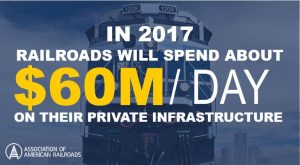 Alexandria, VA — Against the backdrop of a new Congress and Administration in Washington, D.C., the Association of American Railroads announced Wednesday that U.S. freight railroads plan to spend and invest an estimated $22 billion in 2017 to maintain and improve the rail system – an average of more than $60 million per day.
Alexandria, VA — Against the backdrop of a new Congress and Administration in Washington, D.C., the Association of American Railroads announced Wednesday that U.S. freight railroads plan to spend and invest an estimated $22 billion in 2017 to maintain and improve the rail system – an average of more than $60 million per day.
This continues the impressive commitment by railroads to ensuring the American freight rail network can drive economic growth and connect companies and communities to the world.
With more than 20 new members on the House Transportation and Infrastructure and Senate Commerce committees, and a new slate of executive branch officials, there is a great deal of education to be done. These policymakers need to hear from constituents about the importance of maintaining smart and balanced government policies that enable railroads to continue investing in their network at a high level.
The appointment and confirmation of Elaine Chao as Secretary of Transportation and the appointment of Anne Begeman as acting Chairman of the Surface Transportation Board (STB) mean that the leaders of these key agencies are intimately familiar with the freight rail effect, but several important positions remain to be filled, including at the Federal Railroad Administration (FRA) and the STB.
In this new environment, railroads are looking toward regulatory reform that prioritizes performance-based rules that set a standard and let railroads innovate to meet that standard. This would ensure that rules value the desired ends rather than solely their means.
There may also be opportunities for progress toward a sustainable source of funding for the Highway Trust Fund that continues the principle of having highway users pay for highway infrastructure and also promotes equity between modes. When highway users do not pay for their full cost or when policymakers use general fund dollars to fund infrastructure, the movement of freight over highways is incentivized over movement by other modes.
GoRail looks forward, with your help, to educating policymakers in Washington about the public benefits of successful and strong private railroads and to helping advance policies that will give railroads more freedom to innovate while continuing to become even safer and more efficient.


